In this week’s episode of NCLEX Ready, I’ll be sharing with you a few samples of my digital flashcards.
Yes, those same flashcards that have helped me pass the NCLEX on my third try.
I’ve created over two thousand digital flashcards, but this week, we’ll be focusing on the digital flashcards specifically for the ‘Fundamentals of Nursing.’
Whether you’re a nursing student or an aspiring healthcare professional, it’s crucial to grasp the fundamentals of nursing, and these flashcards will help you do just that.
These flashcards will be your secret weapon to mastering complex concepts, acing exams, and becoming a top-notch nurse.
So, grab your scrubs and stethoscopes, and let’s unlock the power of these innovative learning tools together.
Are you ready?
Let’s dive in.
P.S: All the sample digital flashcards in this episode can be downloaded on our website – just click here!
Informed Consent
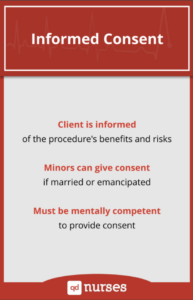
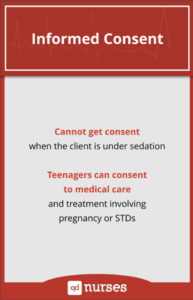
The patient must sign an informed consent stating that they have been informed of the procedure’s benefits and risks. Furthermore, minors can give consent if they are married or emancipated, so pay attention to details provided in the question below. The patient must also be mentally competent to provide consent.
The second informed consent flashcard states that the patient cannot give consent while under sedation. Teenagers can consent to medical care and treatment involving pregnancy or STDs.
Now let’s apply this information to the following question:
Question: A nurse is present when the physician is speaking with the 16-year-old married female that arrived at the clinic for surgery. The physician describes the procedure details and provides possible alternative procedures and treatments. The nurse understands that the patient cannot give informed consent based on this discussion based on which of the following?
- The patient is a minor and cannot give informed consent without a guardian
- There must be two witnesses in the room and there was only one
- A second physician must be in the room as a witness
- The physician did not inform the patient of the procedure’s benefits and risks
Answer: The correct answer is: The physician did not inform the patient of the procedure’s benefits and risks.
Rationale: At the age of 16, the patient is considered a minor, but can give informed consent without a guardian because she is married. While it is preferable to have two witnesses present for the patient to sign an informed consent form, it is not mandatory. Any member of the healthcare team may be a witness. It does not have to be a physician. Remember, the flashcard stated that the patient must be informed of the procedure’s benefits and risks. The NCLEX question stated that the details of the procedures have been provided and alternative procedures and treatments have also been provided. It did NOT mention that the benefits and risks have been provided as well. Therefore, the correct answer is: The physician did not inform the patient of the procedure’s benefits and risks.
Battery vs Assault

It’s very easy to confuse battery and assault. Battery is touching an individual without consent in a harmful way. An example is giving an injection without consent.
Assault is the threat or fear of harm. An example is threatening someone, but not touching the person. It seems misleading because when you think of the word assault, you think of someone actually placing harm. The way I would remember this is throwing a battery at someone is physical.
Now let’s apply what you just learned to this question:
Question: A 21-year-old male keeps moving his arm with the IV needle inserted in the median antecubital site, causing the IV pump to constantly alarm. The nurse states to the patient, “If you make the IV pump alarm one more time, I will tie your arms down.” The patient begins crying. Based on this scenario, the nurse may be accused of which violation?
- Slander
- Battery
- HIPAA violation
- Assault
Answer: Assault.
Rationale: As stated in the flashcard, assault is the threat of harm. In this scenario, the nurse threatened the patient, but did not actually tie the patient’s arms down. The nurse would be accused of battery if action was actually taken to tie the patient’s arms down. HIPAA violation would be if the nurse had revealed the patient’s personal information while discussing this situation to outsiders not involved with the patient’s care. Slander is the nurse making false and damaging statements about the patient.
Biological Emergencies
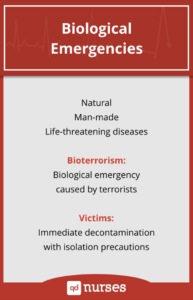
Biological emergencies are natural emergencies, man-made emergencies, or life-threatening diseases emergencies. A biological emergency can be accidental or intentional, but both can make many sick.
Bioterrorism is a biological emergency caused by terrorists. An example would be spreading anthrax.
Victims of biological emergencies require immediate decontamination with isolation precautions.
I can’t stress this part of the flashcard enough. When you encounter a victim that has been affected by a biological emergency, they require IMMEDIATE decontamination with isolation precautions.
Let’s apply what you just learned to the following question:
Question: An emergency nurse is assessing care for a patient that believes he may have been exposed to anthrax. What action should the nurse take next?
- Ask the patient if he’s been vomiting
- Call the physician
- Escort the patient to a decontamination room
- Administer oxygen
Answer: Escort the patient to a decontamination room.
Rationale: As stated in the flashcard above, immediate decontamination with isolation precautions is necessary for victims. To answer this question, you must first realize that anthrax is a biological emergency and must treat the situation as such. The priority with any biological emergency is escorting the patient to a decontamination room.
Calling the physician can be done after taking this initial action. Asking the patient if he’s been vomiting would not confirm that the patient has been exposed to anthrax. While vomiting is one of the signs and symptoms of anthrax exposure, it does not provide confirmation of exposure. Shortness of breath is one of the signs and symptoms of anthrax exposure, so you may want to administer oxygen, but it is not the very next action you should take after finding out that the patient has been exposed to anthrax.
Coding System for Hazards
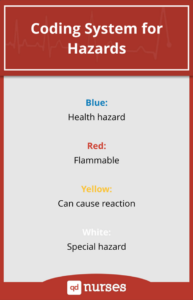
It’s essential for you to know the coding system for hazards. Emergency responders rely on these NFPA color codes to categorize the potential hazard.
Blue symbolizes health hazard, which indicates that there is potential for the material to pose risk to health. If these emergency responders do not use the required personal protective equipment, then the consequences could be harmful.
Red symbolizes flammable hazards. Lowest rating indicates that the material will not burn. Propane gas would have the highest rating in this category.
Yellow symbolizes whether or not a material can cause a reaction. Example is fluorine gas, which is capable of exploding with an initiating source. The reactions can be minor chemical changes or it can be extreme and cause explosive reactions.
White symbolizes special hazard, which categorizes materials that are beyond health, flammability, or instability. Materials that fall in this category are either W, which show unusual reactivity with water, or OX, which are materials that have oxidizing properties.
Each color has a range from 0-4 with 0 being the lowest risk and 4 being the highest risk for concern.
Now let’s apply what you just learned to this question:
Question: The nurse is working in the emergency department and is providing care for a patient who has been exposed to hazardous material. The NFPA 704 diamond on a container displays that the hazardous material has the number 4 in the blue section and the number 0 in the red section. What precautions should the nurse take while handling the situation?
- The material has 0 in red, so special precautions are needed for flammability
- The material has 4 in blue, which is a health hazard so standard precautions and personal protective equipment (PPE) are required
- The material has 4 in blue, which indicates that this is not a risk for a health hazard
- The material has 0 in red, so the nurse should isolate the patient and contact the physician
Answer: The material has 4 in blue, which is a health hazard so standard precautions and personal protective equipment (PPE) are required.
Rationale: A hazard is a substance, material, situation, or condition that has the potential to cause harm. Remember that each color has a range from 0-4 with 0 being the lowest risk and 4 being the highest risk for concern. Based on this, you should automatically eliminate answers 1, 3, and 4.
Chain of Infection
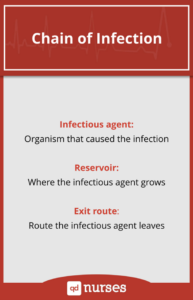

The six links of the chain of infection are: The infectious agent, the reservoir, the portal of exit or exit route, the mode of transmission, the portal of entry, and the susceptible host.
I divided this information into two flashcards to prevent you from feeling overwhelmed with a load of information on one card.
Infectious agent is the organism that causes the infection.
Reservoir is where the infectious agent grows, which could be a person, animal, food, water, etc…
Portal of exit or exit route is the route through which the infectious agent leaves.
The second flashcard continues on to mode of transmission, which is how the infectious agent spreads from one location to another. An example is a handshake or through the air.
Portal of entry is where the infectious agent enters.
Susceptible host is the person who is at risk of becoming infected.
Now let’s apply what you just learned to the following question:
Question: The nurse is educating a group of nursing students about infection control. Understanding the six links in the chain of infection is essential to preventing and controlling the spread of infectious diseases. Which of the following is not part of the chain of infection?
- Handwashing
- Mode of transmission
- Portal of entry
- Reservoir
Answer: Handwashing.
Rationale: It’s easy to select handwashing because it’s a method of infection prevention, but it is not part of the chain of infection. Mode of transmission, portal of entry, and reservoir are part of the chain of infection.
Airborne Precautions
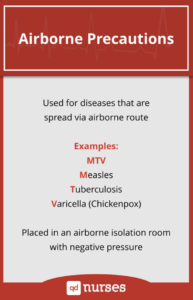
We use airborne precautions for diseases that spread through airborne routes. Use the viral acronym MTV to remember what the airborne diseases are: M for measles, T for tuberculosis, and V for Varicella, also known as chickenpox. You should place a patient with an airborne disease in an airborne isolation room with negative pressure.
Let’s apply what you just learned to the following question:
Question: The nurse is testing a nursing student’s knowledge on infection control regarding isolation precautions. Which of the following infections requires the patient to be placed in an airborne isolation room with negative pressure? Select all that applies:
- Rubella
- Measles
- Varicella
- Tuberculosis
Answer: Measles, varicella, and tuberculosis.
Rationale: Measles, varicella, and tuberculosis are all airborne diseases, which are spread via airborne route. Rubella requires droplet precautions.
Droplet Precautions
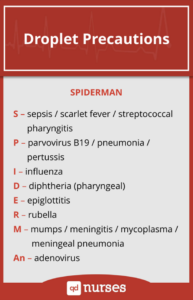
To remember which infections require droplet precautions, think of the viral acronym: The amazing SPIDERMAN!
S is for sepsis, scarlet fever, and streptococcal pharyngitis.
P is for parvovirus B19, pneumonia, pertussis.
I is for influenza.
D is for diphtheria (pharyngeal).
E is for epiglottitis.
R is for rubella.
M is for mumps, meningitis, mycoplasma, and meningeal pneumonia.
An is for adenovirus.
Let’s apply what you just learned to the following question:
NCLEX QUESTION: The nurse is testing a nursing student’s knowledge on infection control regarding isolation precautions. Which of the following infections requires the patient to be placed on droplet precautions? Select all that applies:
- Mumps
- Influenza
- Rubella
- Adenovirus
Answer: All of them.
Rationale: Mumps, influenza, rubella, and adenovirus are all infections that require the patient to be placed on droplet precautions. Remember to use the flashcard for recollection.
Contact Precautions
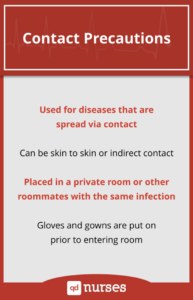
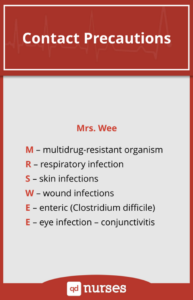
We use contact precautions for diseases that spread through contact. This can occur through skin to skin or indirect contact. You should place patients that have this type of infections in a private room or with other roommates with the same infection. You should put on gloves and gowns prior to entering the room.
Think of the viral acronym Mrs. Wee to help you remember infections that require contact precautions.
M is for multidrug-resistant organisms.
R is for respiratory infection.
S is for skin infections.
W is for wound infections.
E is for enteric, such as clostridium difficile.
E is for eye infection, such as conjunctivitis.
Let’s apply what you just learned from these two flashcards to the following question:
Question: The nurse is providing care for a patient that is diagnosed with MRSA. Which of the following roommates should the nurse place this patient in?
- A patient with varicella
- A patient with MRSA
- A patient with tuberculosis.
- A patient with rubella.
Answer: A patient with MRSA.
Rationale: You should place a patient diagnosed with MRSA either in the same room as another patient with MRSA or in a private room. You should place a patient with varicella or tuberculosis in an airborne isolation room with negative pressure. A patient with rubella requires droplet precautions and you shouldn’t place them in a room with someone diagnosed with MRSA.
Safe Medical Devices Act of 1990
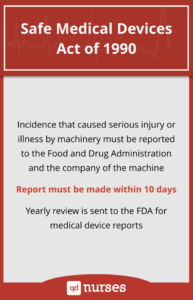
The Safe Medical Devices Act of 1990 requires nurses to report any incident that has caused serious injury or illness by machinery to the Food and Drug Administration and the company of the machine. This is for patient safety as well as legal compliance.
Let’s apply what you just learned to the following question.
Question: The nurse is attempting to provide care for a patient that is experiencing a cardiac emergency. The nurse grabbed the automated external defibrillator (AED), which failed to operate, resulting in a delay in treatment. This is a reportable incident under the Safe Medical Device Act of 1990. What is the timeframe that the nurse needs to provide the report by?
- 48 hours
- 24 hours
- 1 month
- 10 days
Answer: 10 days.
Rationale: Medical devices that cause serious injury or affect patient care must be reported to the Food and Drug Administration within 10 days. Providing reports in a timely manner ensures patient safety as well as regulatory compliance.
I discuss all of this in more depth in the episode above, so make sure to give it a watch and subscribe for more!
